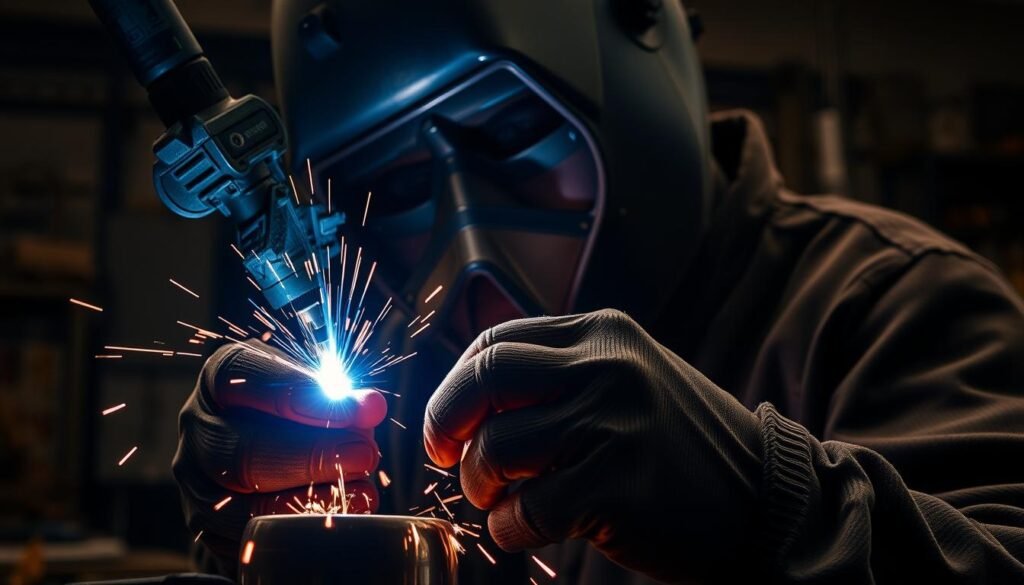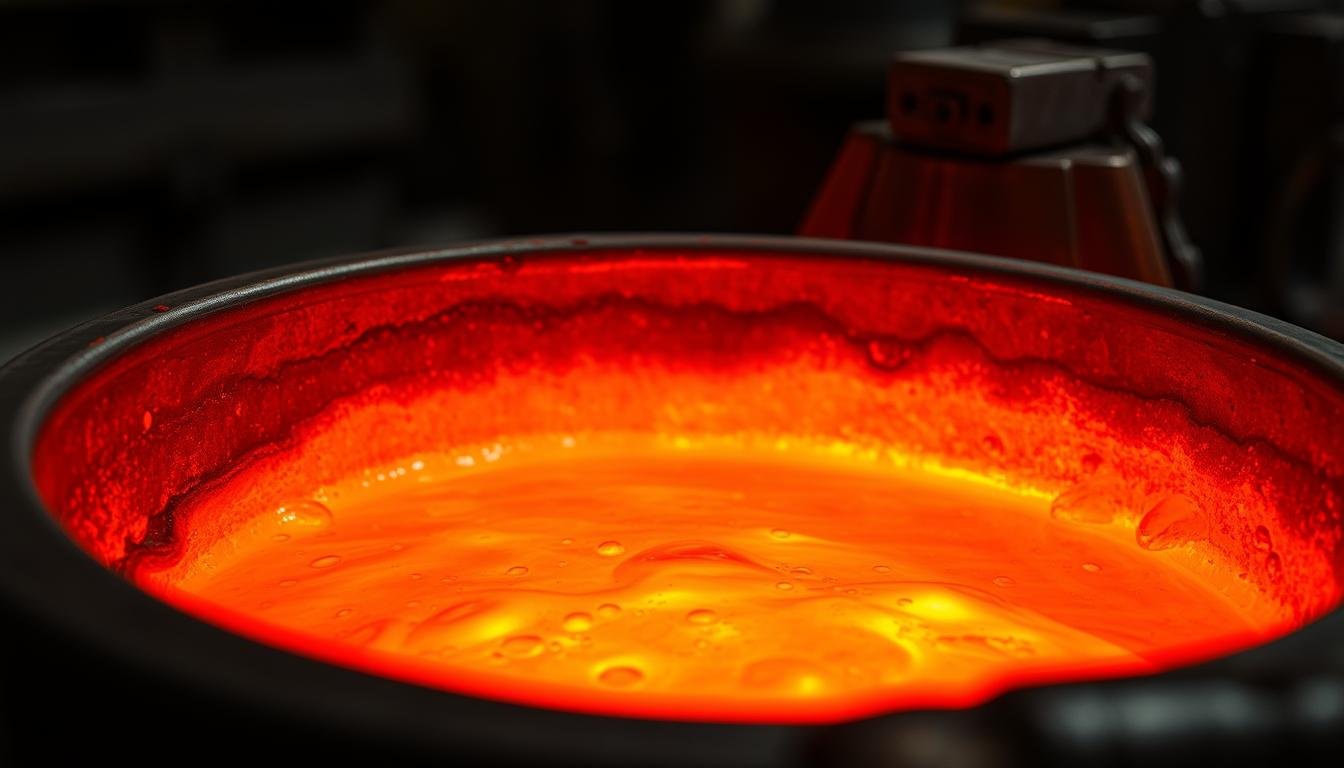Understanding the thermal properties of metals is critical for industrial applications and material science. Pure copper transitions to a liquid state at 1,085°C (1,984°F), a defining characteristic that supports its widespread use in electrical systems, plumbing, and fabrication. This temperature threshold ensures reliability in environments where heat resistance matters most.
Professionals in engineering and manufacturing rely on precise thermal data to optimize processes like welding or alloy production. For instance, knowing how copper behaves under extreme heat helps prevent structural failures in high-stress applications. Its conductivity and durability make it indispensable for circuits, pipelines, and machinery components.
Material scientists often compare this metal’s behavior to alternatives like aluminum or iron. While alloys such as brass melt at lower temperatures, pure copper’s higher threshold provides unmatched stability. Explore detailed comparisons in our melting point analysis for technical insights.
This guide delivers actionable data for selecting materials in construction, electronics, and industrial design. Whether refining production techniques or troubleshooting thermal challenges, accurate temperature knowledge drives smarter decisions.
Introduction to Copper and Its Importance
From ancient tools to cutting-edge tech, this versatile metal has shaped human progress for millennia. Its ability to bend without breaking and conduct energy efficiently makes it indispensable across industries. Even under intense heat, copper retains its form, ensuring reliability in demanding environments.
Significance in Modern Industries
Three key traits define copper’s dominance:
- Adaptability: Easily molded into wires, pipes, or intricate components
- Endurance: Resists corrosion while maintaining electrical efficiency
- Versatility: Powers everything from skyscraper wiring to electric vehicle batteries
Over 60% of global copper production fuels construction and electronics. Renewable energy systems depend on it for solar panels and wind turbines. Automotive manufacturers use 50% more copper in EVs than traditional vehicles.
Artisans and engineers alike value its workability. Architects create striking facades using copper sheets, while factories produce precision parts for aerospace systems. As green tech advances, demand grows for high-performance materials that balance sustainability with functionality.
Fundamental Properties of Copper
Modern engineering relies on materials that balance performance with durability. Among industrial metals, one stands out for its unique combination of thermal efficiency and structural integrity. These characteristics make it a cornerstone in systems requiring rapid energy transfer and long-term reliability.
Thermal Conductivity and Material Strength
With a thermal conductivity rating of 401 W/m·K, this metal outperforms most alternatives in transferring heat efficiently. Its face-centered cubic atomic arrangement allows electrons to move freely, supporting both electrical flow and temperature regulation. This structural advantage explains its dominance in heat exchangers and power grid components.
The material’s density of 8.96 g/cm³ gives it robustness without sacrificing malleability. Engineers value its predictable expansion under temperature shifts, which prevents warping in precision instruments. These traits ensure stability in applications ranging from industrial machinery to renewable energy infrastructure.
Beyond technical specs, the metal’s natural resistance to microbes enhances its role in healthcare and food processing equipment. When combined with its thermal management capabilities, it becomes a dual-purpose solution for hygienic and high-temperature environments. For deeper insights into its performance under extreme conditions, explore our thermal analysis guide.
From microchips to skyscraper HVAC systems, these properties enable innovations that shape modern technology. As industries prioritize efficiency and sustainability, materials with such versatile capabilities remain irreplaceable.
Industrial Applications of Copper and Its Alloys
Across industries, one material consistently powers innovation through its adaptability. Its ability to merge conductivity with durability makes it indispensable for energy systems, construction projects, and advanced manufacturing.
Electrical, Plumbing, and Manufacturing Uses
Electrical grids rely on this metal for 65% of wiring due to unmatched energy transfer efficiency. High-voltage transformers and circuit boards use refined versions to minimize resistance. In residential settings, piping systems benefit from corrosion resistance, ensuring clean water delivery for decades.
Production facilities prioritize this material for its moldability in high-temperature processes. Molten forms are shaped into engine parts, heat exchangers, and architectural elements. Fabricators combine it with zinc or tin to create specialized compounds for niche applications.
Casting and Fabrication Insights
Modern foundries use advanced techniques to produce precision components. Extrusion molds wires as thin as 0.1mm, while rolling forms sheets for roofing and cladding. Automotive manufacturers depend on these methods to craft radiators and brake lines that withstand extreme conditions.
| Alloy Type | Composition | Key Uses |
|---|---|---|
| Brass | Copper + Zinc | Decorative fixtures, musical instruments |
| Bronze | Copper + Tin | Marine hardware, bearings |
| Phosphor Bronze | Copper + Tin + Phosphorus | Electrical connectors, springs |
Welding remains critical for joining parts in aerospace and renewable energy systems. Gas metal arc methods ensure seamless bonds without compromising structural integrity. These practices highlight how tailored approaches maximize performance in complex assemblies.
In-Depth Analysis: copper melting point
Material engineers face critical decisions when selecting metals for high-heat environments. The phase transition threshold determines suitability for applications ranging from circuit boards to industrial furnaces.
Pure Copper vs. Copper Alloys
Pure copper maintains its 1,085°C (1,984°F) threshold across manufacturing processes. This consistency enables reliable performance in:
- Electrical systems requiring stable conductivity
- Plumbing networks needing corrosion resistance
- High-precision machinery components
Alloy formulations alter thermal behavior significantly:
- Brass (900–940°C) melts faster due to zinc content
- Bronze ranges from 950–1,050°C based on tin ratios
- Beryllium blends offer adjustable thresholds (870–1,025°C)
Temperature Conversion: Celsius and Fahrenheit
Global supply chains require accurate unit translations. The conversion formula °F = (°C × 9/5) + 32 ensures precision when:
- Collaborating with international partners
- Calibrating equipment across regions
- Documenting technical specifications
For copper applications, 1,085°C converts to 1,985°F – a critical reference point in American manufacturing standards. This dual-scale understanding prevents errors in material selection and process design.
Comparing Copper with Other Metals
Material selection in industrial design hinges on understanding how metals perform under heat and stress. Engineers weigh factors like thermal thresholds, density, and conductivity to match materials with project demands. This analysis reveals why specific metals dominate critical applications.
Copper vs. Aluminum
Aluminum’s 660°C phase transition temperature makes it 50% easier to melt than copper. This lower energy requirement suits mass production of lightweight components like aircraft frames. However, copper’s 1,085°C threshold ensures stability in electrical systems where heat buildup occurs.
The density gap further defines their roles. Aluminum’s 2.7 g/cm³ weight advantage drives its use in automotive and aerospace designs. Copper’s heftier 8.96 g/cm³ profile becomes an asset in heat exchangers and power cables needing robust thermal transfer.
Copper vs. Steel and Other Metals
Steel’s 1,538°C melting point surpasses copper’s by 454°C, making it ideal for structural beams in skyscrapers. Yet copper’s conductivity remains unmatched—97% of U.S. electrical wiring relies on it despite steel’s strength.
| Metal | Melting Point (°C) | Primary Use |
|---|---|---|
| Aluminum | 660 | Aerospace components |
| Steel (Iron) | 1,538 | Construction frameworks |
| Silver | 961 | High-end electronics |
| Tungsten | 3,422 | Industrial furnace parts |
“In high-temperature applications, material choice isn’t just about durability—it’s about energy efficiency and long-term cost,”
While precious metals like gold and silver melt near copper’s range, their expense limits use to specialized circuits. Tungsten’s extreme 3,422°C threshold serves niche roles, but copper’s balance of affordability and performance secures its industrial dominance.
Impact of Alloys, Impurities, and Microstructure on Melting Temperature
Customizing material behavior through precise additives has revolutionized modern metallurgy. Even minor compositional changes can transform how metals respond to heat, stress, and environmental factors.
How Composition Shapes Thermal Resistance
Alloying elements reshape atomic interactions in three key ways:
- Atomic structure: Nickel reinforces crystalline bonds, creating higher melting point alloys (1,100–1,200°C)
- Bond strength: Lead disrupts lattice formations, causing up to 150°C reductions
- Energy dynamics: Phosphorus introduces weak interfaces that collapse under lower heat
Microstructural details prove equally critical. Fine-grained materials reach phase transitions faster due to increased surface area. Stress patterns from manufacturing processes can create unpredictable hot spots during heating cycles.
Industrial applications demand careful balancing. Electrical connectors use copper-nickel blends for stable conductivity under load. Decorative fixtures often incorporate zinc for easier shaping without sacrificing structural form.
Metallurgists employ advanced microscopy to map grain boundaries and impurity distribution. This data informs precise formulations for aerospace components and renewable energy systems. As one industry expert notes:
“Controlling alloy composition isn’t chemistry—it’s thermal engineering at atomic scales.”
Environmental and Pressure Effects on Copper’s Melting Behavior
External factors play a decisive role in how materials respond to thermal stress. Variations in atmospheric pressure and ambient conditions directly impact phase transitions during industrial processes.
Atmospheric Pressure and External Conditions
Standard air pressure (1 atm/101.325 kPa) maintains the baseline thermal threshold for pure materials. When pressure increases:
- Atomic compression strengthens molecular bonds
- Higher energy input becomes necessary
- Phase transitions occur at elevated temperatures
Industrial environments often operate under modified pressure conditions. For example, hydraulic forging systems require 15-20% more thermal energy compared to standard foundry operations.
| Pressure Level | Effect on Thermal Threshold | Common Applications |
|---|---|---|
| 1 atm | Baseline reference | Standard casting |
| High (3-5 atm) | +50-75°C increase | Aerospace components |
| Vacuum (0.01 atm) | -10-15°C reduction | Electronics manufacturing |
Oxidation risks multiply in oxygen-rich environments. A study by the Materials Processing Institute found humid conditions increase energy consumption by 12-18% during smelting operations. Protective atmospheres using argon or nitrogen prevent surface degradation while maintaining thermal efficiency.
“Controlling environmental variables isn’t optional – it’s what separates functional materials from failed prototypes.”
Altitude changes further complicate processing. Facilities in Denver (1,600m elevation) require different calibration than those in Miami to account for atmospheric differences. Modern monitoring systems track these variables in real-time to ensure consistent quality.
Welding Copper: Techniques and Considerations
Proper joining methods determine the longevity and reliability of metal components in demanding applications. Skilled technicians balance heat management with material properties to create durable bonds that withstand stress and temperature fluctuations.
MIG and TIG Welding Methods
MIG welding dominates industrial settings due to its speed and adaptability. The process requires 20-30% higher power settings compared to steel to counteract rapid heat dissipation. Specialized wire feeders and gas mixtures (like argon-helium blends) improve penetration in thicker sections.

TIG welding excels in precision work for thin materials below 0.125 inches. Pure argon shielding prevents oxidation while allowing controlled heat input. Experienced welders often preheat workpieces to 300-400°F for consistent results, particularly in complex joint configurations.
Brazing Techniques as an Alternative
When fusion welding risks distortion, brazing offers a lower-temperature solution. Silver-based fillers flow between surfaces at 1,112-1,652°F, forming bonds through capillary action. This method preserves base material properties while accommodating intricate designs.
Advanced applications use phosphor-copper alloys for self-fluxing joints in electrical systems. Proper groove preparation and flux application ensure optimal adhesion without reaching the parent metal’s thermal threshold. As one aerospace fabricator notes:
“Brazed joints in cooling systems handle vibration better than welded ones – it’s all about matching method to mission.”
Methods to Melt Copper Safely
Safety protocols are non-negotiable when transforming metals into liquid states for industrial use. Proper handling of molten copper demands rigorous preparation and specialized tools. Facilities prioritize minimizing exposure to extreme heat while maintaining precise control over the process.
Essential Safety Equipment and Protective Gear
Workers must wear gear rated for high-temperature environments. Heat-resistant gloves and aprons shield against accidental splashes from molten copper. Full-face shields with auto-darkening lenses protect eyes during furnace operations. Ventilation systems prevent toxic fume buildup in enclosed spaces.
Temperature Monitoring Best Practices
Accurate tracking ensures materials reach optimal flow without overheating. Digital thermocouples provide real-time data on furnace conditions. Infrared pyrometers measure surface temperature remotely, reducing direct contact risks. Regular calibration of sensors maintains consistency across batches.
Advanced heat management systems automatically adjust energy output based on readings. This prevents thermal runaway in large-scale operations. Pairing these tools with trained oversight creates a safety net for critical processes.
From protective equipment to smart monitoring, these methods safeguard workers while optimizing productivity. Adhering to protocols ensures reliable outcomes in metalworking applications nationwide.
